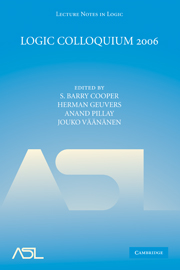Book contents
- Frontmatter
- Contents
- Introduction
- Definability and elementary equivalence in the Ershov difference hierarchy
- A unified approach to algebraic set theory
- Brief introduction to unprovability
- Higher-order abstract syntax in type theory
- An introduction to b-minimality
- The sixth lecture on algorithmic randomness
- The inevitability of logical strength: Strict reverse mathematics
- Applications of logic in algebra: Examples from clone theory
- On finite imaginaries
- Strong minimal covers and a question of Yates: The story so far
- Embeddings into the Turing degrees
- Randomness—beyond Lebesgue measure
- The derived model theorem
- Forcing axioms and cardinal arithmetic
- Hrushovski's amalgamation construction
Strong minimal covers and a question of Yates: The story so far
Published online by Cambridge University Press: 28 January 2010
- Frontmatter
- Contents
- Introduction
- Definability and elementary equivalence in the Ershov difference hierarchy
- A unified approach to algebraic set theory
- Brief introduction to unprovability
- Higher-order abstract syntax in type theory
- An introduction to b-minimality
- The sixth lecture on algorithmic randomness
- The inevitability of logical strength: Strict reverse mathematics
- Applications of logic in algebra: Examples from clone theory
- On finite imaginaries
- Strong minimal covers and a question of Yates: The story so far
- Embeddings into the Turing degrees
- Randomness—beyond Lebesgue measure
- The derived model theorem
- Forcing axioms and cardinal arithmetic
- Hrushovski's amalgamation construction
Summary
Abstract. An old question of Yates as to whether all minimal degrees have a strong minimal cover remains one of the longstanding problems of degree theory, apparently largely impervious to present techniques. We survey existing results in this area, focussing especially on some recent progress.
Introduction. By the 60's and 70's degree theorists had become concerned with some particular and fundamental questions of a global nature concerning the structure of the Turing degrees. In order to address issues regarding homogeneity and the decidability and degree of the theory, the approach taken at this time was to proceed through a deep analysis of the initial segments of the structure. Along these lines a technique for piecemeal construction of initial segments, even if only locally successful, would have been very useful and it was in this context that interest was first aroused in a question of Yates:
definition 1.1. A degree b is a strong minimal cover for a if D[< b] = D[≤ a]. A degree a is minimal if it is a strong minimal cover for 0.
Question 1.1 (Yates). Does every minimal degree have a strong minimal cover?
In fact, the question of characterizing those degrees with strong minimal cover had already been raised by Spector in his 1956 paper [CS]. Certainly in Dm—the structure of the many-one degrees, induced by a strengthening of the Turing reducibility—Lachlan's proof of the fact that every m-degree has a strong minimal cover played a vital role in Ershov's [YE] and Paliutin's [EP] results characterizing the structure and in showing, for instance, that 0m is the only definable singleton.
- Type
- Chapter
- Information
- Logic Colloquium 2006 , pp. 213 - 228Publisher: Cambridge University PressPrint publication year: 2009
- 1
- Cited by



